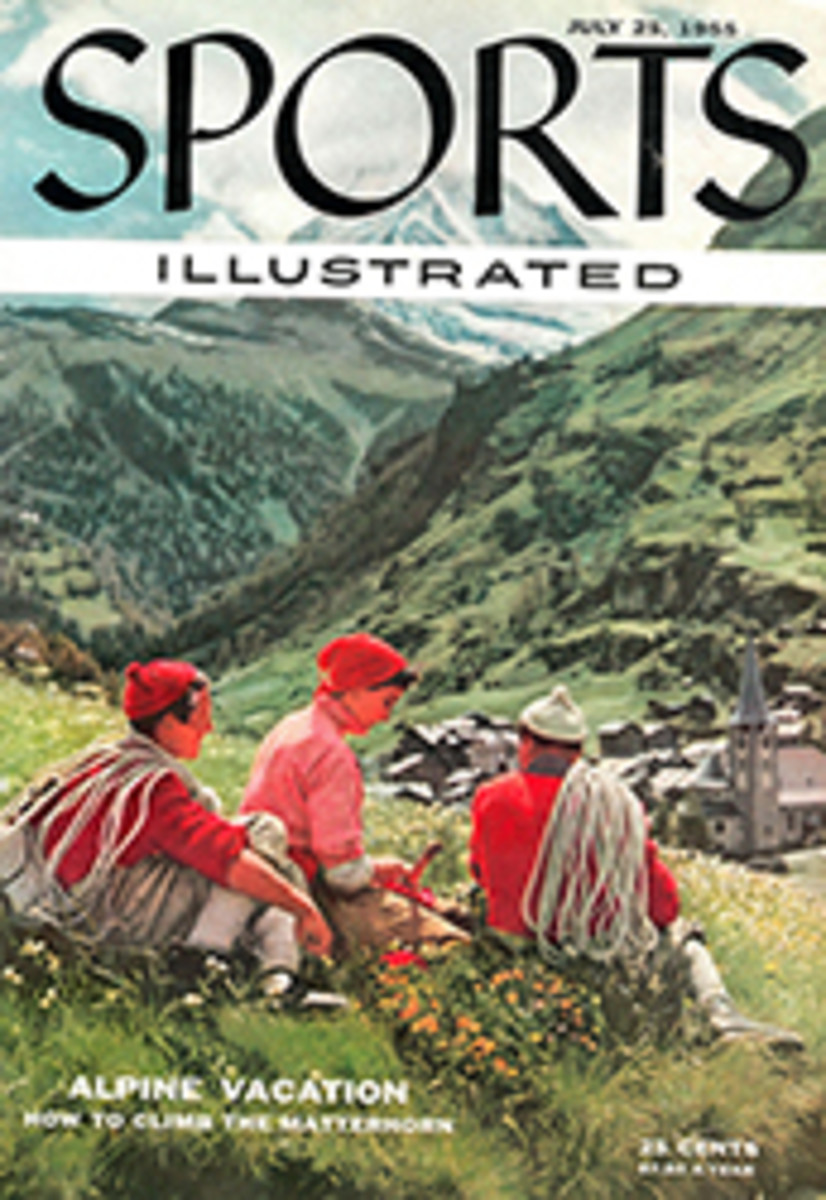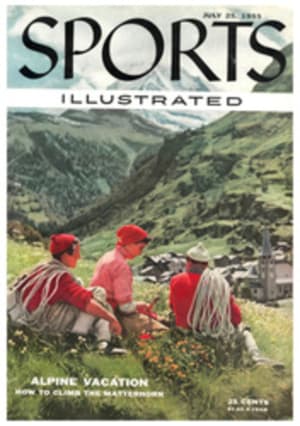
IN THE AINTREE GRAND PRIX MERCEDES PROVES THAT IT HAS THE BEST RACING CAR AND THE BEST RACING TEAM IN THE WORLD
Mercedes-Benz, in this fourth year of its postwar resurrection, has become to motor racing what Rocky Marciano is to heavyweight boxing—a seemingly invincible combination of tremendous stamina and superb preparedness. This was proved once more, and conclusively, at Liverpool's Aintree Course last Saturday when the trim, silver cars from West Germany, with Stirling Moss in the lead, scooped the eighth British Grand Prix in the first quadruple victory in Grand Prix history.
For Moss it was a personal triumph, the realization of a lifelong ambition: his first Grand Prix conquest. It was a dramatic grandstand finish, too, as Moss, leader by a hair-thin margin for 80 laps, swept across the line one-fifth of a second ahead of his Argentinian teammate Fangio; and the 150,000 Britons pyramided around the track forgot all their reserve as they burst through the barriers to congratulate their national hero. It came almost as an afterthought that, with Kling third and Taruffi fourth, the German team had also broken Ferrari's five-year monopoly on the checkered flag for this top-drawer British event.
Aintree is a brutally hard circuit on engines, a destructive acceleration battle with only brief breathing spells in fourth speed. Said Moss: "I must have changed gears 2,000 times for those 90 laps." What this did to the rest of the field is evident from the fact that only nine of the 24 starters lasted the race, and of the Italian, British and French opposition, only one Maserati finished in good shape, tailing the fourth Mercedes by nearly two minutes.
For the start, Moss held the pole position with the fastest practice lap—89.70 mph. Fangio, two-tenths of a second slower, was beside him, then Behra with the 250F Maserati. Kling and Taruffi shared the second row, and in the third were the Maseratis of Mieres and Simon, with Schell's fuel-injection British Vanwall between them.
From the start, Mercedes held the lead and it was a two-way battle between Moss and Fangio all the way. Fangio, in No. 10, led for two laps, harried by Moss in No. 12 and a close-packed field. On lap three Moss passed him, holding first position until the 18th lap when the Argentinian world champion again went ahead. On the 26th lap, Moss took command once more to stay ahead until the checkered flag. Behra's Maserati, just ahead of Kling and Taruffi but 10 seconds behind the leaders, staged a valiant battle for third place until the ninth lap, when it stopped in a cloud of smoke.
The Maseratis of Mieres and Musso got by Taruffi's Mercedes, but on lap 48 Mieres quit with piston trouble. Try as he might, Musso could make no impression on Kling, who in turn was one minute 10 seconds behind the two leaders at the halfway mark. Finally, on lap 55, Taruffi after many tries repassed Musso and gradually pulled away, completing the Mercedes quartet. Veteran "Silver Fox" Taruffi's performance was magnificent. Clad in his perennial blue pullover, getting dirtier every lap, handling a car he had never driven until the day before, on a course unfamiliar to him, he clung grimly to fourth spot, one lap behind.
The works Ferraris of Trintignant, Hawthorn and Castellotti were disappointing. Castellotti, never higher than eighth, retired on lap 18 with transmission trouble. Trintignant, seventh on lap 61, blew a cylinder-head gasket. Hawthorn, cooked by the sun's rays filtering through his visor, was seventh when he handed over to Castellotti on the 47th lap. This car eventually finished sixth, three laps behind the leaders. The Gordinis of Ramos and Manzon, hopelessly outclassed, both retired early, leaving Sparken's lame Gordini to struggle on to the end.
Fangio's smile was a trifle wan as the bouquets were handed out. Said he in his voluble Spanish: "My congratulations to Moss. He is a wonderful driver. I had a lot of fun following him." To which Moss, who took the laurels at 86.47 mph and set a new lap record at 89.70 mph, sportingly retorted: "If Fangio had tried a little harder, things might have been very different."
The 17-lap 51-mile sports car race preceding the Grand Prix was an all-British affair which drew 22 entries. After the third lap, when Salvadori, Collins, Parnell and Walker in turn each got by Mike Hawthorn's D-type Jaguar, it also become an all Aston-Martin affair. In fact, the stalwart Aston-Martins had no trouble in eventually disposing altogether of the three D-Jaguars driven by Hawthorn, Titterington and Berry. Peter Collins, first to tackle Hawthorn on Becher's bend, put up the fastest lap at 83.33 mph. Roy Salvadori's winning speed was 81.32 mph. Only 1.7 seconds separated the first three cars.
There were 30 starters in the opening event, also of 51 miles, for 500-cc Formula 3 machines; and the blip of their exhausts, garlanded around the course, sounded like a field day for noisemakers. Russell's Cooper-Norton, which passed Lewis Evans' similar car on lap seven, went on to win a hard-fought battle and set a new lap record of 79.53 mph. Fergusson in another Cooper-Norton was third, some distance behind. The leaders lapped the field at half-distance and Russell clocked a sizzling 78.19 mph.
ILLUSTRATION
"What snake? She's tryin' to hit the ball!"

